Please report any broken links or trouble you might come across to the Webmaster.
Please take a moment to let us know so that we can correct any problems and make your visit as enjoyable and as informative as possible.
| Click On Image For Full Size | Size | Image Description | Source | |
|---|---|---|---|---|
 | 1.16k | L Class Profile Inboard; Profile Outboard. | National Archives Identifier: 78116763 Photo courtesy of catalog.archives.gov | |
 | 1.36k | Superstructure Deck; Battery Deck for the L-2 (SS-41). | National Archives Identifier: 78116844 Photo courtesy of catalog.archives.gov | |
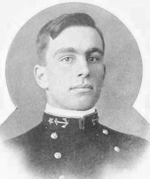 0804116 | 99k | Augustine H. Gray, the 1st Co of L-2 (SS-41). | Photo courtesy of findagrave.com | |
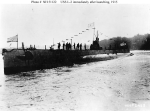 | 76k | L-2 (SS-41), afloat immediately after her launching, at the Fore River Shipbuilding Company, Quincy, Massachusetts, on 11 February 1915. | USNHC photograph, # NH 51122. | |
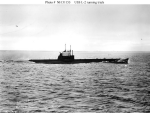 | 80k | L-2 (SS-41) making 14 knots while running trials off Provincetown, Massachusetts. Though the original print bears a date of March 1915, this photograph was probably taken later, perhaps in March 1916. | Official USN photo # NH 51153, now in the collections of the National Archives, courtesy of U.S. Naval Historical Center. | |
 |
297k | L-2 (SS-41), off Provincetown, Mass., circa 1915-16. | USN photo courtesy of ussubvetsofwwii.org. | |
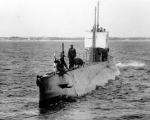 | 64k | Bow view of the L-2 (SS-41) off Provincetown, Mass., circa 1915-16. | Official USN photo courtesy of USNI. | |
 |
743k | All the news that's fit to misprint, #1. UNITED STATES TESTS FIRST OF BIG NEW SEA-GOING SUBMARINES The M-1 (SS-47) is shown on her trial trip off Provincetown, Mass., on 6 July. She is 230 1/2 feet long, with 21 1/2-foot beam. Her radius of action is 2,000 miles. She is not as large as the German submarine Deutschland, now at Baltimore, whose length is 315 feet, with a 30 foot beam. It is actually an EB design L-class boat. The paper that originally published the photo misidentified it. The caption is wrong. | Photo & text i.d. courtesy of David Johnston Image provided by: Penn State University Libraries; University Park, PA. Photo from Evening Public Ledger. (Philadelphia [Pa.]) 1914-1942, 11 July 1916, Night Extra, Image 2, via chroniclingamerica.loc.gov. | |
 |
531k | All the news that's fit to misprint, # 2. LARGEST SUBMARINE STANDS STIFF TEST Above is a picture of the U.S. submarine M-1 (SS-47) the largest submarine of our navy. She was photographed while being put through an exciting trip at Provincetown. Mass. She can travel 5000 miles without a stop, 1000 more than was covered by the Deutschland.". It is actually an EB design L-class boat. The paper that originally published the photo misidentified it. The caption is wrong. | Photo & text i.d. courtesy of David Johnston Image and text provided by University of North Texas; Denton, TX. Photo from El Paso Herald. (El Paso, Tex.) 1901-1931, 21 July 1916, HOME EDITION, Image 6, via chroniclingamerica.loc.gov. | |
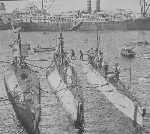 | 46k | "Officials of the City of Havana leaving the submarine L-2 (SS-41) after a ceremonious visit to a group of L-boats of the U.S. submarine division on it's recent visit to the Cuban capital. Said to have been the first time American submarines have visited that city." | Photo by Underwood & Underwood, courtesy of memory.loc.gov. Text courtesy of N.Y. Times, 14 January 1917, Page 3. | |
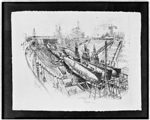 |
127k | What looks to be L-class (SS-40/51) submarines in dry dock, by the artist Joseph Pennell, 1917. | Photo # 3c19552v, LC-USZ62-119552. Photograph courtesy of memory.loc.gov. | |
 |
496k | A MOTHER SEADOG GUARDING HER PUPPIES This interesting photograph was taken within the Charlestown Navy Yard, where the United States submarine tender Tonopah (M-8) lies at anchor with her undersea charges, comprising submarine fleet No.3, of the North Atlantic fleet. Probable submarines are the E.B. designed L-boats (SS-40 / 43 & 49 / 51), [L-1 thru 4 & 9 thru 11.] | Image and text provided by Penn State University Libraries; University Park, PA. Photo from Evening Public Ledger.(Philadelphia [Pa.]) 1914-1942, 02 June 1917, Postscript Edition, Pictorial Section, Image 19, via chroniclingamerica.loc.gov. |
|
 |
65k | A Mackay style camouflage Tonopah (M-8) taken while she was serving as submarine tender at the Boston Navy Yard, Charlestown, Massachusetts, 21 December 1917. The submarine alongside is probably an early L-boat; L-1 (SS-40) or L-4 (SS-43). (Note the misspelling in the caption). | USN photo courtesy of National Park Service, Boston National Historical Park Collection, NPS cat. no. BOSTS-14445, submitted by Stephen P. Carlson, Preservation Specialist, Boston NHP, Charlestown Navy Yard. Photo i.d. courtesy of Aryeh Wetherhorn. | |
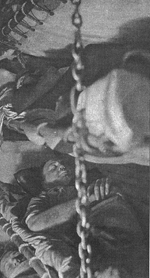 |
753k | Sack Time. Typical of the subject submarines, here men are stacked four high on canvas fold away bunks aboard an American L-boat in the European theater. | Photo from Illustrated London News, 28 September, 1918, courtesy of Beneath the Surface: World War I Submarines Built in Seattle and Vancouver by Bill Lightfoot. | |
 0804107 | 1.83k | L-2 (SS-41) as AL-2 while over there. | Photo courtesy of Thomas Crane Public Library, Fore River Shipyard Postcard Collection @ digitalcommonwealth.org | |
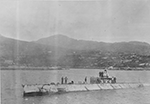 | 418k | L-2 (SS-41) in Bantry Bay, Ireland, in 1918. A copy of this photograph in the collection of Vice Admiral Paul F. Foster, USNR (Retired), L-2's World War I Commanding Officer, has the following caption: "The L-2 in Bantry Bay, Ireland, after encounter with the German Submarine UB-65 on 10 July 1918 off Fastnet Light, Ireland, which resulted in the sinking of the UB-65." unfortunatelyfor reality, the U-boat was not sunk by this sub. | National Archives Identifier: 45513713 Local Identifier: 165-WW-338B-011 Photo courtesy of catalog.archives.gov | |
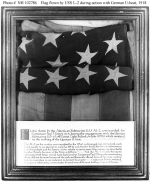 | 115k | U.S. National Ensign flown by L-2 (SS-41) during her 10 July 1918 encounter with the German submarine UB-65 off Fasnet Light, Ireland. UB-65 was sunk on this occasion. L-2 was commanded at that time by Lieutenant Paul F. Foster, USN. | USNHC photograph, # NH 102786. Collection Vice Admiral Paul F. Foster, USNR, donated by his estate in 1976. | |
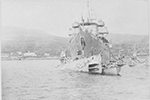 | 221k | Bushnell (AS-2) lifting L-2 (SS-41) partially out of the water, while in an Irish port during World War I.
Moored to Bushnell's
port side are (from left to right): L-4 (SS-43), L-1 (SS-40), & L-9 (SS-49). | National Archives Identifier: 45513749 Local Identifier: 165-WW-338B-28 Photo courtesy of catalog.archives.gov | |
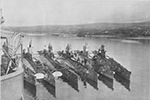 | 1.02k | L-boats alongside Bushnell (AS-2) at Bantry Bay, Ireland, in 1918.
These submarines are, from left to right: L-11 (SS-51), L-10 (SS-50), L-1 (SS-40), L-9 (SS-49) & L-2 (SS-41). Identification marks painted on these "boats"' fairwaters include the letter "A", to distinguish them from British L-boats . | National Archives Identifier: 45513695 Local Identifier: 165-WW-338B-003 Photo courtesy of catalog.archives.gov | |
 |
113k | In the foreground is L-4 (SS-43), while just visible in the background is the conning tower of L-2 (SS-41), probably off Ireland, 1918. | Vance Adams for his father, Lt. Vance Adams USN Ret (deceased). | |
 0804117 | 740k | Lieutenant Commander Augustine H. Gray (center, with hands behind his back) conversing with a Navy Lieutenant and two U.S. Army officers, while the Princess Matoika (ID 2290) was at St. Nazaire, France, 20 December 1918. Note the six-inch gun behind them. | Photo NH-52875 courtesy of history.navy.mil | |
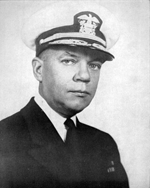 |
74k | Admiral Francis Stuart Low was born in Albany, New York, on 15 August 1894, son of the late Commander William Franklin Low, USN, and Mrs. Anna (Stuart) Low. He attended High School in Newton, Massachusetts and US Naval Academy, graduating from the latter with the Class of 1915. In 1926 he completed the junior course at the Naval War College, Newport, Rhode Island. His first assignments after graduation were in the battleship Connecticut (BB-18) and cruiser Montana (ACR-13). In the early part of his illustrious career, he was designated a submariner, and commanded the submarines D-3 (SS-19), O-9 (SS-70), L-1 (SS-40), L-2 (SS-41), S-12 (SS-117), and served on the staffs of Commander Submarine Division FIVE and Commander Control Force during and subsequent to World War One. This continuous sea duty from 1915 to 1925 was briefly interrupted for a six months assignment with the Tactical Group Submarine Chasers, New London, Connecticut. | Text & USN photo courtesy of Bill Gonyo. | |
 | 366k | Loading a MK7 Bliss-Leavitt torpedo aboard the drydocked submarines L-2 (SS-41) & L-4 (SS-43) when they were based at Bantry Bay, Ireland, between January 1918 & 1919. The MK7 was 17.7 inches diameter and 17 feet long & weighed 1628 pounds. | Photo & text i.d. courtesy of Ric Hedman. National Archives Identifier: 45514059 Local Identifier: 165-WW-339C-40 Photo courtesy of catalog.archives.gov | |
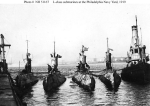 | 89k | L-class class submarines tied up at the Philadelphia Navy Yard, Pennsylvania, with a harbor tug outboard, circa February 1919. Submarines are (from left to right): L-3 (SS-42); L-9 (SS-49); L-11 (SS-51); and L-2 (SS-41). | USNHC photograph, # NH 51167. | |
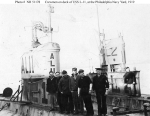 | 77k | L-11 (SS-51) with crew members on deck, at the Philadelphia Navy Yard, circa February 1919. L-2 (SS-41), is in the immediate background. | USNHC photograph, # NH 51178. | |
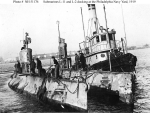 | 116k | L-11 (SS-51) at left, and L-2 (SS-41), docking at the Philadelphia Navy Yard, Pennsylvania, assisted by a harbor tug, circa February 1919. | USNHC photograph, # NH 51176. | |
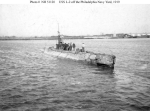 | 80k | L-2 (SS-41) off the Philadelphia Navy Yard, Pennsylvania, circa February 1919. | Official USN photo # NH 51120, now in the collections of the National Archives. Courtesy of the U.S. Naval Historical Center. | |
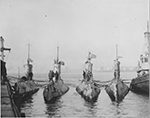 |
873k | AMERICAN U-BOATS BACK FROM THE WAR After 15 months hunting of German U-boats in the Irish Sea, the flotilla of submarines shown above returned to the League Island navy yard at Philadelphia. The L-11 (SS-51), (third from left) had many desperate encounters with the enemy boats, including a fight below the surface with a Hun sub, which L-11 subsequently vanquished. L-9 (SS-49) is the second boat to the left, along with two unidentified submarines, which I believe are L-2 (SS-41) at the far right & L-3 (SS-42) on the left. |
National Archives Identifier: 45513697 Local Identifier: 165-WW-338B-3A Photo courtesy of catalog.archives.gov Image and text provided by University of Oregon Libraries; Eugene, OR. Photo courtesy of The Evening Herald. The Evening Herald. (Klamath Falls, Or.) 1906-1942, 24 April 1919, Image 3, via chroniclingamerica.loc.gov. | |
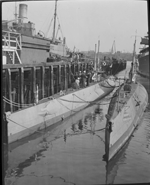 |
244k | L-1 (SS-40) & L-2 (SS-41) at Boston Navy Yard, circa 1918-20. | Photo # 08_06_023227 courtesy of the Boston Public Library, Leslie Jones Collection via Sean Hert & flickr.com. | |
 0807700 | 674k | Philadelphia in the late 1920ís. From left to right: Two K-class: (No definite i.d. which ones of the following 8 ): K-1 (SS-32), K-2 (SS-33), K-3 (SS-34), K-4 (SS-35), K-5 (SS-36), K-6 (SS-37), K-7 (SS-38), K-8 (SS-39). Four EB design L-class (No definite i.d. which ones of the following 4 ): L-2 (SS-41), L-3 (SS-42), L-9 (SS-49) & L-11 (SS-51). Two Lake design O-class (No definite i.d. which ones of the first 4): O-11 (SS-72), O-13 (SS-74), O-14 (SS-75), O-15 (SS-76 ), with the last boat being O-16 (SS-77) on far right. All boats are in various states of disrepair, and all would be disposed of by scrapping by the summer of 1930 in accordance with the London Naval Treaty. | Photo courtesy of David Wright. Text i.d. via David Johnston. |
|
| Back To The Main Photo Index | Back To the Submarine Index |
|
Problems and site related matters, E-mail Webmaster |
|
This page is created by Gary Priolo and maintained by Michael Mohl All Pages © 1996 - 2025 NavSource History |